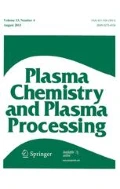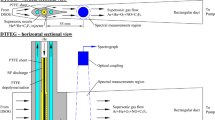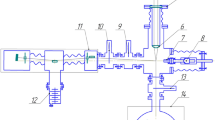Abstract
Optical emission intensities in the sheath region are not the same as those in the plasma region. This is because not only the electron density, but also the electron temperature, is different between the two regions. In this study a Cu rod is inserted into the plasma, and the rod potential is altered from the ground potential to a negative potential with a frequency of 20 Hz. The optical emission ray comes from the sheath region when the negative potential is applied, but comes form the plasma region at the ground potential. We can immediately detect the difference of the emission intensities between the plasma and the sheath regions by a lock-in amplifier. The pre-amplifier is placed prior to the lock-in amplifier. By using this pre-amplifier the output signal of the lock-in amplifier can be adjusted to zero for any emission line. the emission spectra from a CF4+O2 plasma are measured. A small amount of Ar gas and/or N2 gas is added and the output signal of the lock-in amplifier is adjusted to zero for either the Ar emission line or the N2 emission line. In a fluorine-contained plasma the F emission intensity normalized by the Ar one has been widely used in order to obtain the F density. This validity is confirmed by the present experiment. It is also confirmed that the CO emission intensity normalized by that of N2 is proportional to the CO density. The metastable states play an important role in the optical emission intensities of CO and N2 molecules.
Similar content being viewed by others
References
W. R. Harshbarger, T. A. Miller, P. Norton, and R. A. Porter,Appl. Spectrosc. 31, 201 (1977).
R. A. Gottscho and M. L. Mandich,J. Vac. Sci. Technol. A 3, 617 (1985).
C. J. Mogab, A. C. Adams, and D. L. Flamm,J. Appl. Phys. 49, 3796 (1978).
K. Ninomiya, K. Suzuki, and S. Nishimatsu,Jpn. J. Appl. Phys. 22, 139 (1983).
J. W. Coburn and M. Chen,J. Appl. Phys. 51, 3134 (1980).
R. d'Agostino, F. Cramarossa, S. De Benedictis, and F. Fracassi,Plasma Chem. Plasma Process.4 163 (1984).
H. Kawata, K. Murata, and K. Nagami,J. Electrochem. Soc. 132, 206 (1985).
K. Kohler, J. W. Coburn, D. E. Horne, E. Kay, and J. H. Keller,J. Appl. Phys. 57, 59 (1985).
A. H. P. Skelland,Diffusional Mass Transfer, Wiley, New York (1974), pp. 49–54.
H. Kawata, T. Shibano, K. Murata, and K. Nagami,J. Electrochem. Soc. 129, 1325 (1982).
H. Kawata, K. Murata, and K. Nagami,J. Vac. Sci. Technol. B 4, 6 (1986).
Y. Horiike and M. Shibagaki,Suppl. Jpn. J. Appl. Phys. 15, 13 (1976).
G. S. Selwyn and E. Kay,Plasma Chem. Plasma Process 5, 183 (1985).
Author information
Authors and Affiliations
Rights and permissions
About this article
Cite this article
Kawata, H., Takao, Y., Murata, K. et al. Optical emission spectroscopy of CF4+O2 plasmas using a new technique. Plasma Chem Plasma Process 8, 189–206 (1988). https://doi.org/10.1007/BF01016157
Received:
Revised:
Issue Date:
DOI: https://doi.org/10.1007/BF01016157




